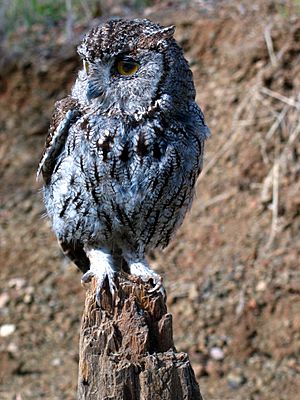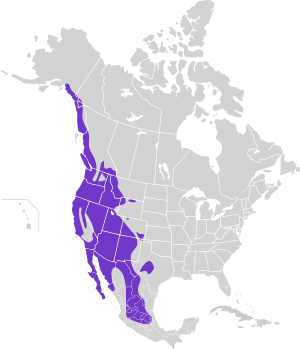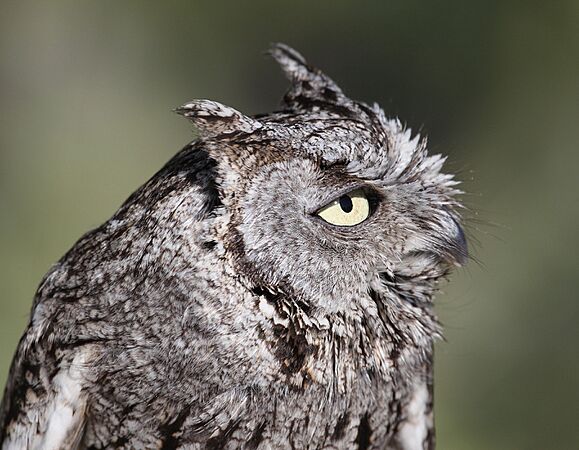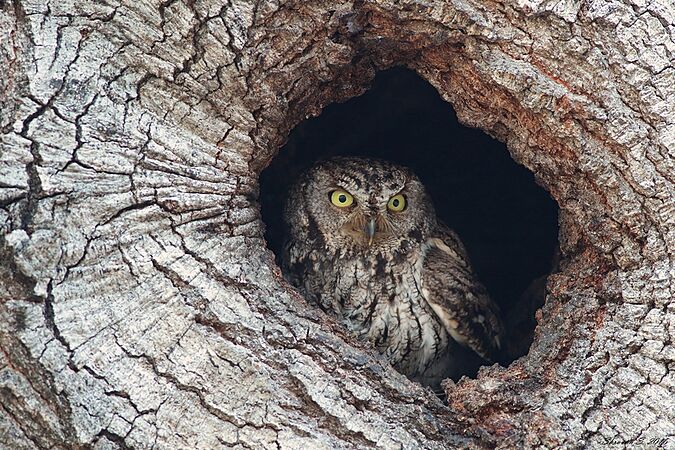Western screech owl facts for kids
Quick facts for kids Western screech owl |
|
|---|---|
 |
|
| Conservation status | |
| Scientific classification | |
| Genus: |
Megascops
|
| Species: |
kennicottii
|
| Subspecies | |
|
See text |
|
 |
|
| Synonyms | |
|
Otus kennicottii |
|
The western screech owl (Megascops kennicottii) is a small owl that lives in North and Central America. It is a close relative of the eastern screech owl. This owl was named after an American scientist named Robert Kennicott.
Contents
What They Look Like
Western screech owls are about 22 centimeters (9 inches) long. Their wings can spread up to 55 centimeters (22 inches) wide. They usually weigh around 143 grams (5 ounces). Female owls are bigger than males. Owls living in northern areas are also larger than those in southern areas.
These owls can have different colors. Some are brown, and some are dark gray. They all have streaks on their bellies. You won't find a red western screech owl.
They have a round head with special feather tufts that look like ears. They have bright yellow eyes and a yellowish beak. Western screech owls look a lot like whiskered screech owls and eastern screech owls. The best way to tell them apart is by listening to their calls. People used to think they were the same species as the eastern screech owl.
What Do They Sound Like?
The main sound a western screech owl makes is a quick series of short whistles. These whistles get faster and faster. They also make a trill sound that starts short and then gets longer, dropping slightly at the end. Other sounds they make include barking and chuckling noises. They can also let out a high-pitched screech.
Scientists have studied the songs of western screech owls. They found that male owls' main songs are about 30% lower in sound than female owls' songs. This helps tell them apart!
Where They Live
The western screech owl lives in many countries. You can find them in Canada, the United States, Mexico, Guatemala, El Salvador, Honduras, Costa Rica, and Nicaragua.
They like to live in different places. These include forests, shrublands, and deserts. You might even spot them in fields, suburban parks, and gardens.
Reproduction
Western screech owls stay in the same area all year long. They live in the northwest parts of North America and Central America. They usually make their nests in open woods or at the edges of forests.
They often use holes in trees or cacti for their nests. These holes are usually made by woodpeckers. Female owls usually lay four to five eggs. The young owls hatch around the time when other birds are migrating in the spring. After these birds pass through, the screech owls sometimes hunt the young birds that have just learned to fly.
What Do They Eat?
Western screech owls are good hunters. They wait on a branch and then swoop down to catch their food. They can also catch insects while flying. They hunt at dawn, night, or dusk. They use their excellent hearing and night vision to find prey.
Their diet mostly includes small mammals like mice and rats. They also eat birds and large insects. These owls are clever hunters and will eat what they can find. Sometimes, they even catch small fish at night. They have been known to hunt Mallard ducks and cottontail rabbits too.
Different Types of Western Screech Owls
There are nine different types, or subspecies, of the western screech owl. Each type has slight differences, often based on where they live. Some of these types include:
- Megascops kennicottii aikeni
- Megascops kennicottii bendirei
- Megascops kennicottii cardonensis
- Megascops kennicottii kennicottii
- Megascops kennicottii macfarlanei
- Megascops kennicottii suttoni
- Megascops kennicottii vinaceus
- Megascops kennicottii xantusi
- Megascops kennicottii yumanensis
Gallery
-
A western screech owl at the Desert Museum
See also
 In Spanish: Tecolote occidental para niños
In Spanish: Tecolote occidental para niños





